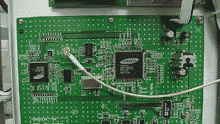New DTV receive chip set announced


Fox, Philips and a collegiate alliance are trying to develop a third-generation ATSC receive chipset. Pictured here is a first-generation receive chipset.
Under an agreement between Fox, Philips Semiconductor and an Australian college, data collection and data analysis was conducted last year with the goal of producing the next generation of ATSC receive chips. For this study Fox provided extensive data collection of ATSC channel characterization for laboratory and field analysis. The data was gleaned from four local Fox O&Os. The DTV reception data was gathered from 1,100 locations in four cities (New York, Los Angeles, Chicago and Atlanta.) The data was collected via two passes. The first set of tests identified problematic indoor receive sites. The second set of tests returned to the problem sites to record additional data for use in the lab.
The data collected was sent to Philips Semiconductors' laboratory in Briarcliff Manor, N.Y. Philips Research was responsible for contributing algorithmic and architectural modifications to improve the performance of 8-VSB receivers. Philips conducted software tests on the data collected to determine improved channel equalization techniques that might be implemented in a next generation of ATSC demod chips. Australian National University also assisted in determining channel characterization and receiver improvement aspects for the project. Improvements in receive characteristics can be implemented in silicon using DSP concepts implemented via IIR and FIR adaptive filtering techniques. Philips and Fox both hope that a next generation of receive chips will fall out of the tests. At this time no date has been announced as to when the new chipset will be available.
Andrew G. Setos, Fox Group President of Engineering, said at the beginning of the project almost three years ago, that Fox's partnership with Philips was the key needed to improve ATSC performance. He observed at the time that color TV took off because RCA owned NBC and made color TV sets. Since that level of vertical integration doesn't exist today, FOX said it created a “virtual one" with Philips.
The results of the study were published in the most recent issue of the Institute for Electrical and Electronics Engineers' IEEE Transactions on Broadcasting journal. According to the study, indoor reception rates were 85 percent of the locations tested. But the study also found that use of two receive antennas in an antenna diversity scheme could greatly improve an ATSC’s receiver to successfully demod 8-VSB signals in multipath situations. Fox claims that this next generation of DTV receive chipsets being developed should end the ATSC modulation controversy. Setos said the chip set would be made available to all consumer-electronics manufacturers from Philips Semiconductor when it becomes available.
For more information visit www. philips.com
The professional video industry's #1 source for news, trends and product and tech information. Sign up below.
